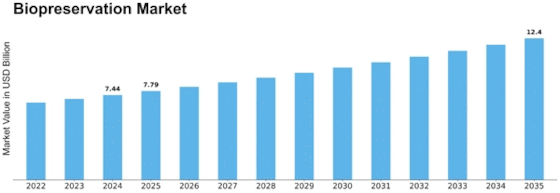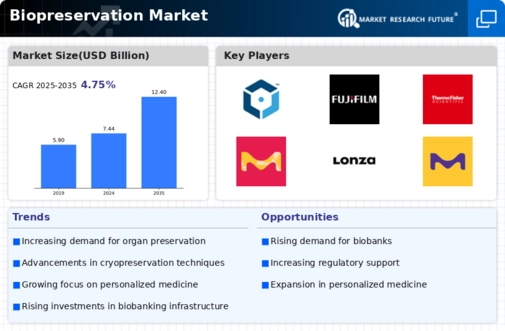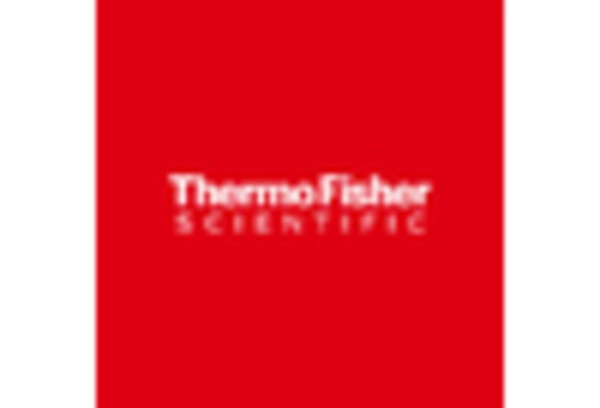Cell and Tissue Culture
Gene and Drug Therapy
Clinical Applications
Regenerative Medicine
Biopreservation Media
Freezers
Cryogenic Storage Systems
Accessories
Biotechnology Companies
Pharmaceutical Companies
Research Institutions
Hospitals and Clinics
Cryopreservation
Controlled Rate Freezing
Ultra-Low Temperature Storage
North America
Europe
South America
Asia Pacific
Middle East and Africa
North America Outlook (USD Billion, 2019-2035)
North America Biopreservation Market by Application Type
Cell and Tissue Culture
Gene and Drug Therapy
Clinical Applications
Regenerative Medicine
North America Biopreservation Market by Product Type
Biopreservation Media
Freezers
Cryogenic Storage Systems
Accessories
North America Biopreservation Market by End User Type
Biotechnology Companies
Pharmaceutical Companies
Research Institutions
Hospitals and Clinics
North America Biopreservation Market by Storage Type
Cryopreservation
Controlled Rate Freezing
Ultra-Low Temperature Storage
North America Biopreservation Market by Regional Type
US
Canada
US Outlook (USD Billion, 2019-2035)
US Biopreservation Market by Application Type
Cell and Tissue Culture
Gene and Drug Therapy
Clinical Applications
Regenerative Medicine
US Biopreservation Market by Product Type
Biopreservation Media
Freezers
Cryogenic Storage Systems
Accessories
US Biopreservation Market by End User Type
Biotechnology Companies
Pharmaceutical Companies
Research Institutions
Hospitals and Clinics
US Biopreservation Market by Storage Type
Cryopreservation
Controlled Rate Freezing
Ultra-Low Temperature Storage
CANADA Outlook (USD Billion, 2019-2035)
CANADA Biopreservation Market by Application Type
Cell and Tissue Culture
Gene and Drug Therapy
Clinical Applications
Regenerative Medicine
CANADA Biopreservation Market by Product Type
Biopreservation Media
Freezers
Cryogenic Storage Systems
Accessories
CANADA Biopreservation Market by End User Type
Biotechnology Companies
Pharmaceutical Companies
Research Institutions
Hospitals and Clinics
CANADA Biopreservation Market by Storage Type
Cryopreservation
Controlled Rate Freezing
Ultra-Low Temperature Storage
Europe Outlook (USD Billion, 2019-2035)
Europe Biopreservation Market by Application Type
Cell and Tissue Culture
Gene and Drug Therapy
Clinical Applications
Regenerative Medicine
Europe Biopreservation Market by Product Type
Biopreservation Media
Freezers
Cryogenic Storage Systems
Accessories
Europe Biopreservation Market by End User Type
Biotechnology Companies
Pharmaceutical Companies
Research Institutions
Hospitals and Clinics
Europe Biopreservation Market by Storage Type
Cryopreservation
Controlled Rate Freezing
Ultra-Low Temperature Storage
Europe Biopreservation Market by Regional Type
Germany
UK
France
Russia
Italy
Spain
Rest of Europe
GERMANY Outlook (USD Billion, 2019-2035)
GERMANY Biopreservation Market by Application Type
Cell and Tissue Culture
Gene and Drug Therapy
Clinical Applications
Regenerative Medicine
GERMANY Biopreservation Market by Product Type
Biopreservation Media
Freezers
Cryogenic Storage Systems
Accessories
GERMANY Biopreservation Market by End User Type
Biotechnology Companies
Pharmaceutical Companies
Research Institutions
Hospitals and Clinics
GERMANY Biopreservation Market by Storage Type
Cryopreservation
Controlled Rate Freezing
Ultra-Low Temperature Storage
UK Outlook (USD Billion, 2019-2035)
UK Biopreservation Market by Application Type
Cell and Tissue Culture
Gene and Drug Therapy
Clinical Applications
Regenerative Medicine
UK Biopreservation Market by Product Type
Biopreservation Media
Freezers
Cryogenic Storage Systems
Accessories
UK Biopreservation Market by End User Type
Biotechnology Companies
Pharmaceutical Companies
Research Institutions
Hospitals and Clinics
UK Biopreservation Market by Storage Type
Cryopreservation
Controlled Rate Freezing
Ultra-Low Temperature Storage
FRANCE Outlook (USD Billion, 2019-2035)
FRANCE Biopreservation Market by Application Type
Cell and Tissue Culture
Gene and Drug Therapy
Clinical Applications
Regenerative Medicine
FRANCE Biopreservation Market by Product Type
Biopreservation Media
Freezers
Cryogenic Storage Systems
Accessories
FRANCE Biopreservation Market by End User Type
Biotechnology Companies
Pharmaceutical Companies
Research Institutions
Hospitals and Clinics
FRANCE Biopreservation Market by Storage Type
Cryopreservation
Controlled Rate Freezing
Ultra-Low Temperature Storage
RUSSIA Outlook (USD Billion, 2019-2035)
RUSSIA Biopreservation Market by Application Type
Cell and Tissue Culture
Gene and Drug Therapy
Clinical Applications
Regenerative Medicine
RUSSIA Biopreservation Market by Product Type
Biopreservation Media
Freezers
Cryogenic Storage Systems
Accessories
RUSSIA Biopreservation Market by End User Type
Biotechnology Companies
Pharmaceutical Companies
Research Institutions
Hospitals and Clinics
RUSSIA Biopreservation Market by Storage Type
Cryopreservation
Controlled Rate Freezing
Ultra-Low Temperature Storage
ITALY Outlook (USD Billion, 2019-2035)
ITALY Biopreservation Market by Application Type
Cell and Tissue Culture
Gene and Drug Therapy
Clinical Applications
Regenerative Medicine
ITALY Biopreservation Market by Product Type
Biopreservation Media
Freezers
Cryogenic Storage Systems
Accessories
ITALY Biopreservation Market by End User Type
Biotechnology Companies
Pharmaceutical Companies
Research Institutions
Hospitals and Clinics
ITALY Biopreservation Market by Storage Type
Cryopreservation
Controlled Rate Freezing
Ultra-Low Temperature Storage
SPAIN Outlook (USD Billion, 2019-2035)
SPAIN Biopreservation Market by Application Type
Cell and Tissue Culture
Gene and Drug Therapy
Clinical Applications
Regenerative Medicine
SPAIN Biopreservation Market by Product Type
Biopreservation Media
Freezers
Cryogenic Storage Systems
Accessories
SPAIN Biopreservation Market by End User Type
Biotechnology Companies
Pharmaceutical Companies
Research Institutions
Hospitals and Clinics
SPAIN Biopreservation Market by Storage Type
Cryopreservation
Controlled Rate Freezing
Ultra-Low Temperature Storage
REST OF EUROPE Outlook (USD Billion, 2019-2035)
REST OF EUROPE Biopreservation Market by Application Type
Cell and Tissue Culture
Gene and Drug Therapy
Clinical Applications
Regenerative Medicine
REST OF EUROPE Biopreservation Market by Product Type
Biopreservation Media
Freezers
Cryogenic Storage Systems
Accessories
REST OF EUROPE Biopreservation Market by End User Type
Biotechnology Companies
Pharmaceutical Companies
Research Institutions
Hospitals and Clinics
REST OF EUROPE Biopreservation Market by Storage Type
Cryopreservation
Controlled Rate Freezing
Ultra-Low Temperature Storage
APAC Outlook (USD Billion, 2019-2035)
APAC Biopreservation Market by Application Type
Cell and Tissue Culture
Gene and Drug Therapy
Clinical Applications
Regenerative Medicine
APAC Biopreservation Market by Product Type
Biopreservation Media
Freezers
Cryogenic Storage Systems
Accessories
APAC Biopreservation Market by End User Type
Biotechnology Companies
Pharmaceutical Companies
Research Institutions
Hospitals and Clinics
APAC Biopreservation Market by Storage Type
Cryopreservation
Controlled Rate Freezing
Ultra-Low Temperature Storage
APAC Biopreservation Market by Regional Type
China
India
Japan
South Korea
Malaysia
Thailand
Indonesia
Rest of APAC
CHINA Outlook (USD Billion, 2019-2035)
CHINA Biopreservation Market by Application Type
Cell and Tissue Culture
Gene and Drug Therapy
Clinical Applications
Regenerative Medicine
CHINA Biopreservation Market by Product Type
Biopreservation Media
Freezers
Cryogenic Storage Systems
Accessories
CHINA Biopreservation Market by End User Type
Biotechnology Companies
Pharmaceutical Companies
Research Institutions
Hospitals and Clinics
CHINA Biopreservation Market by Storage Type
Cryopreservation
Controlled Rate Freezing
Ultra-Low Temperature Storage
INDIA Outlook (USD Billion, 2019-2035)
INDIA Biopreservation Market by Application Type
Cell and Tissue Culture
Gene and Drug Therapy
Clinical Applications
Regenerative Medicine
INDIA Biopreservation Market by Product Type
Biopreservation Media
Freezers
Cryogenic Storage Systems
Accessories
INDIA Biopreservation Market by End User Type
Biotechnology Companies
Pharmaceutical Companies
Research Institutions
Hospitals and Clinics
INDIA Biopreservation Market by Storage Type
Cryopreservation
Controlled Rate Freezing
Ultra-Low Temperature Storage
JAPAN Outlook (USD Billion, 2019-2035)
JAPAN Biopreservation Market by Application Type
Cell and Tissue Culture
Gene and Drug Therapy
Clinical Applications
Regenerative Medicine
JAPAN Biopreservation Market by Product Type
Biopreservation Media
Freezers
Cryogenic Storage Systems
Accessories
JAPAN Biopreservation Market by End User Type
Biotechnology Companies
Pharmaceutical Companies
Research Institutions
Hospitals and Clinics
JAPAN Biopreservation Market by Storage Type
Cryopreservation
Controlled Rate Freezing
Ultra-Low Temperature Storage
SOUTH KOREA Outlook (USD Billion, 2019-2035)
SOUTH KOREA Biopreservation Market by Application Type
Cell and Tissue Culture
Gene and Drug Therapy
Clinical Applications
Regenerative Medicine
SOUTH KOREA Biopreservation Market by Product Type
Biopreservation Media
Freezers
Cryogenic Storage Systems
Accessories
SOUTH KOREA Biopreservation Market by End User Type
Biotechnology Companies
Pharmaceutical Companies
Research Institutions
Hospitals and Clinics
SOUTH KOREA Biopreservation Market by Storage Type
Cryopreservation
Controlled Rate Freezing
Ultra-Low Temperature Storage
MALAYSIA Outlook (USD Billion, 2019-2035)
MALAYSIA Biopreservation Market by Application Type
Cell and Tissue Culture
Gene and Drug Therapy
Clinical Applications
Regenerative Medicine
MALAYSIA Biopreservation Market by Product Type
Biopreservation Media
Freezers
Cryogenic Storage Systems
Accessories
MALAYSIA Biopreservation Market by End User Type
Biotechnology Companies
Pharmaceutical Companies
Research Institutions
Hospitals and Clinics
MALAYSIA Biopreservation Market by Storage Type
Cryopreservation
Controlled Rate Freezing
Ultra-Low Temperature Storage
THAILAND Outlook (USD Billion, 2019-2035)
THAILAND Biopreservation Market by Application Type
Cell and Tissue Culture
Gene and Drug Therapy
Clinical Applications
Regenerative Medicine
THAILAND Biopreservation Market by Product Type
Biopreservation Media
Freezers
Cryogenic Storage Systems
Accessories
THAILAND Biopreservation Market by End User Type
Biotechnology Companies
Pharmaceutical Companies
Research Institutions
Hospitals and Clinics
THAILAND Biopreservation Market by Storage Type
Cryopreservation
Controlled Rate Freezing
Ultra-Low Temperature Storage
INDONESIA Outlook (USD Billion, 2019-2035)
INDONESIA Biopreservation Market by Application Type
Cell and Tissue Culture
Gene and Drug Therapy
Clinical Applications
Regenerative Medicine
INDONESIA Biopreservation Market by Product Type
Biopreservation Media
Freezers
Cryogenic Storage Systems
Accessories
INDONESIA Biopreservation Market by End User Type
Biotechnology Companies
Pharmaceutical Companies
Research Institutions
Hospitals and Clinics
INDONESIA Biopreservation Market by Storage Type
Cryopreservation
Controlled Rate Freezing
Ultra-Low Temperature Storage
REST OF APAC Outlook (USD Billion, 2019-2035)
REST OF APAC Biopreservation Market by Application Type
Cell and Tissue Culture
Gene and Drug Therapy
Clinical Applications
Regenerative Medicine
REST OF APAC Biopreservation Market by Product Type
Biopreservation Media
Freezers
Cryogenic Storage Systems
Accessories
REST OF APAC Biopreservation Market by End User Type
Biotechnology Companies
Pharmaceutical Companies
Research Institutions
Hospitals and Clinics
REST OF APAC Biopreservation Market by Storage Type
Cryopreservation
Controlled Rate Freezing
Ultra-Low Temperature Storage
South America Outlook (USD Billion, 2019-2035)
South America Biopreservation Market by Application Type
Cell and Tissue Culture
Gene and Drug Therapy
Clinical Applications
Regenerative Medicine
South America Biopreservation Market by Product Type
Biopreservation Media
Freezers
Cryogenic Storage Systems
Accessories
South America Biopreservation Market by End User Type
Biotechnology Companies
Pharmaceutical Companies
Research Institutions
Hospitals and Clinics
South America Biopreservation Market by Storage Type
Cryopreservation
Controlled Rate Freezing
Ultra-Low Temperature Storage
South America Biopreservation Market by Regional Type
Brazil
Mexico
Argentina
Rest of South America
BRAZIL Outlook (USD Billion, 2019-2035)
BRAZIL Biopreservation Market by Application Type
Cell and Tissue Culture
Gene and Drug Therapy
Clinical Applications
Regenerative Medicine
BRAZIL Biopreservation Market by Product Type
Biopreservation Media
Freezers
Cryogenic Storage Systems
Accessories
BRAZIL Biopreservation Market by End User Type
Biotechnology Companies
Pharmaceutical Companies
Research Institutions
Hospitals and Clinics
BRAZIL Biopreservation Market by Storage Type
Cryopreservation
Controlled Rate Freezing
Ultra-Low Temperature Storage
MEXICO Outlook (USD Billion, 2019-2035)
MEXICO Biopreservation Market by Application Type
Cell and Tissue Culture
Gene and Drug Therapy
Clinical Applications
Regenerative Medicine
MEXICO Biopreservation Market by Product Type
Biopreservation Media
Freezers
Cryogenic Storage Systems
Accessories
MEXICO Biopreservation Market by End User Type
Biotechnology Companies
Pharmaceutical Companies
Research Institutions
Hospitals and Clinics
MEXICO Biopreservation Market by Storage Type
Cryopreservation
Controlled Rate Freezing
Ultra-Low Temperature Storage
ARGENTINA Outlook (USD Billion, 2019-2035)
ARGENTINA Biopreservation Market by Application Type
Cell and Tissue Culture
Gene and Drug Therapy
Clinical Applications
Regenerative Medicine
ARGENTINA Biopreservation Market by Product Type
Biopreservation Media
Freezers
Cryogenic Storage Systems
Accessories
ARGENTINA Biopreservation Market by End User Type
Biotechnology Companies
Pharmaceutical Companies
Research Institutions
Hospitals and Clinics
ARGENTINA Biopreservation Market by Storage Type
Cryopreservation
Controlled Rate Freezing
Ultra-Low Temperature Storage
REST OF SOUTH AMERICA Outlook (USD Billion, 2019-2035)
REST OF SOUTH AMERICA Biopreservation Market by Application Type
Cell and Tissue Culture
Gene and Drug Therapy
Clinical Applications
Regenerative Medicine
REST OF SOUTH AMERICA Biopreservation Market by Product Type
Biopreservation Media
Freezers
Cryogenic Storage Systems
Accessories
REST OF SOUTH AMERICA Biopreservation Market by End User Type
Biotechnology Companies
Pharmaceutical Companies
Research Institutions
Hospitals and Clinics
REST OF SOUTH AMERICA Biopreservation Market by Storage Type
Cryopreservation
Controlled Rate Freezing
Ultra-Low Temperature Storage
MEA Outlook (USD Billion, 2019-2035)
MEA Biopreservation Market by Application Type
Cell and Tissue Culture
Gene and Drug Therapy
Clinical Applications
Regenerative Medicine
MEA Biopreservation Market by Product Type
Biopreservation Media
Freezers
Cryogenic Storage Systems
Accessories
MEA Biopreservation Market by End User Type
Biotechnology Companies
Pharmaceutical Companies
Research Institutions
Hospitals and Clinics
MEA Biopreservation Market by Storage Type
Cryopreservation
Controlled Rate Freezing
Ultra-Low Temperature Storage
MEA Biopreservation Market by Regional Type
GCC Countries
South Africa
Rest of MEA
GCC COUNTRIES Outlook (USD Billion, 2019-2035)
GCC COUNTRIES Biopreservation Market by Application Type
Cell and Tissue Culture
Gene and Drug Therapy
Clinical Applications
Regenerative Medicine
GCC COUNTRIES Biopreservation Market by Product Type
Biopreservation Media
Freezers
Cryogenic Storage Systems
Accessories
GCC COUNTRIES Biopreservation Market by End User Type
Biotechnology Companies
Pharmaceutical Companies
Research Institutions
Hospitals and Clinics
GCC COUNTRIES Biopreservation Market by Storage Type
Cryopreservation
Controlled Rate Freezing
Ultra-Low Temperature Storage
SOUTH AFRICA Outlook (USD Billion, 2019-2035)
SOUTH AFRICA Biopreservation Market by Application Type
Cell and Tissue Culture
Gene and Drug Therapy
Clinical Applications
Regenerative Medicine
SOUTH AFRICA Biopreservation Market by Product Type
Biopreservation Media
Freezers
Cryogenic Storage Systems
Accessories
SOUTH AFRICA Biopreservation Market by End User Type
Biotechnology Companies
Pharmaceutical Companies
Research Institutions
Hospitals and Clinics
SOUTH AFRICA Biopreservation Market by Storage Type
Cryopreservation
Controlled Rate Freezing
Ultra-Low Temperature Storage
REST OF MEA Outlook (USD Billion, 2019-2035)
REST OF MEA Biopreservation Market by Application Type
Cell and Tissue Culture
Gene and Drug Therapy
Clinical Applications
Regenerative Medicine
REST OF MEA Biopreservation Market by Product Type
Biopreservation Media
Freezers
Cryogenic Storage Systems
Accessories
REST OF MEA Biopreservation Market by End User Type
Biotechnology Companies
Pharmaceutical Companies
Research Institutions
Hospitals and Clinics
REST OF MEA Biopreservation Market by Storage Type
Cryopreservation
Controlled Rate Freezing
Ultra-Low Temperature Storage


















Leave a Comment